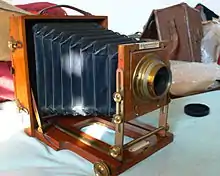J. Lancaster & Son
J. Lancaster & Son was a photographic company, formed in Birmingham, England, in 1835 when James Lancaster started an optical firm for the manufacture of glasses, microscopes, and telescopes.[1][2][3][4][5]

 J. Lancaster & Son name plate. | |
| Industry | Photography |
|---|---|
| Founded | 1835 |
| Defunct | 1955 |
| Fate | Dissolved |
| Headquarters | , |
| Owner | James Lancaster |
The company was an optician and camera maker, based in Irving Street, Birmingham. It was one of the world's major camera makers in 1898. It made wooden view cameras, among them several cameras for smaller plate formats. Lancaster made its own lenses and had patents for shutters. Other products were magic lanterns and photographic enlargers.[6]
.jpg.webp)
History
James Lancaster founded the firm of James Lancaster in 1835 on Bull Street in Birmingham. It manufactured spectacles, telescopes and microscopes. It manufactured its wares in a series of small workshops. In 1853, it moved to 37 Colmore Row where it remained until 1907, though it retained the Bull Street property for manufacturing.
.jpg.webp)
In 1870, William James Lancaster, his son took over and in 1871 the name was changed to J. Lancaster & Son. William James refocused the company to include photographic products and popularising them with the public. In 1879 they were offering the Lancaster Pocket Camera, which took 4 ¼ in × 3¼ inch plates and a Gem camera taking multiple images called the Lancaster Carte Camera.
There is a reference in 1874 that Lancaster was producing a pocket camera, reviewed in the British Journal of Photography.
More models followed, Le Merveilleux, Le Meritoire and the Instantograph in 1882, and the pocket watch camera in 1886. In 1898 it claimed to be the world's largest camera manufacturer having sold over 200,000 cameras.
It became a limited company in 1905, becoming J. Lancaster & Son. Ltd and this is recorded on subsequent camera labels. W. J. Lancaster died in 1925 and the firm ceased trading in 1955.[7]
Products
- The 1/4-plate Instantograph was one of the better known.
- Le Merveilleux
- Le Meritoire
- Gem Apparatus of 1880, a camera with twelve lenses to shoot the same subject twelve times at once. [7]
- Telescopic Patent Watch Camera in pocket watch format
Gallery
 Model 7497.
Model 7497. Model 7506.
Model 7506. Model 7507.
Model 7507.
References
- "J. Lancaster & Son Ltd". Historic camera. Retrieved 13 March 2013.
- "Waterford County Museum". 1900 B.B. Instantograph. Waterford County Museum. Retrieved 13 March 2013.
- "Lancaster price guide". collectiblend.com. Retrieved 13 March 2013.
- Berly, Jules Albert (1883). J.A. Berly's British, American and Continental Electrical Directory and Advertiser. Wm. Dawson & Sons. p. 117.
- Crookes, Sir William (31 July 1874). The British Journal of Photography. Vol. 21. H. Greenwood. p. 361.
- Graces Guide 2015.
- Historic Cameras 1503.
Bibliography
- "J Lancaster & Son". Graces Guide. Retrieved 16 July 2015.
- "J. Lancaster & Son Ltd". History Librarium. Historic Camera. Retrieved 16 July 2015.
- "Councillor W.J. Lancaster J.P." - biography, in Handsworth magazine